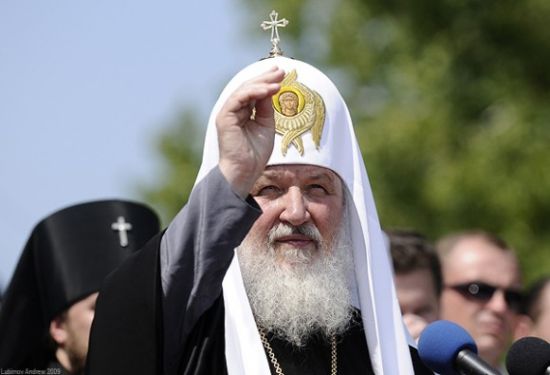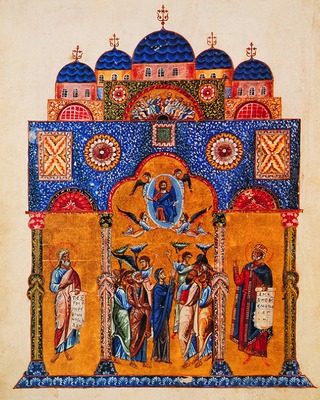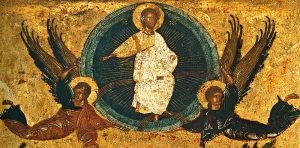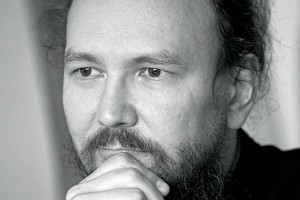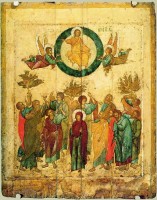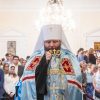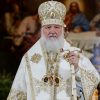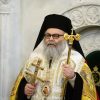The following is a chapter from Word of a Pastor, a catechetical book written by His Holiness, Patriarch Kirill of Moscow and All Russia. We wish His Holiness many years on the occasion of his name-day, celebrated today. Eis polla eti despota!
The Gospel tells of still another appearance by the Risen Lord. This took place in Galilee, to which the Apostles had been commanded to go by the Savior through the Myrrh-Bearing Women: Go tell My brethren that they go into Galilee, and there shall they see Me (Matthew 28:10).
This appearance of the Risen Savior to His disciples is recorded in the twenty-first and final chapter of the Gospel according to John.
Seven disciples – Simon Peter, and Thomas called Didymus, and Nathanael of Cana in Galilee, and the sons of Zebedee, and two other of His disciples – were fishing at night in the Sea of Tiberias, but did not catch anything.
But when the morning was now come, Jesus stood on the shore: but the disciples knew not that it was Jesus. And He said unto them, Cast the net on the right side of the ship, and ye shall find. They cast therefore, and now they were not able to draw it for the multitude of fishes. Therefore that disciple whom Jesus loved saith unto Peter, It is the Lord. Now when Simon Peter heard that it was the Lord, he girt his fisher’s coat unto him, (for he was naked,) and did cast himself into the sea. And the other disciples came in a little ship (for they were not far from land, but as it were two hundred cubits,) dragging the net with fishes. As soon then as they were come to land, they saw a fire of coals there, and fish laid thereon, and bread. Jesus saith unto them, Bring of the fish which ye have now caught. Simon Peter went up, and drew the net to land full of great fishes, an hundred and fifty and three: and for all there were so many, yet was not the net broken. Jesus saith unto them, Come and dine. And none of the disciples durst ask Him, Who art Thou? knowing that it was the Lord (John 21:2, 4-12).
There are at least three points in this account that should draw our attention.
First, there is the account’s extraordinary scrupulousness of detail. The Evangelist John specifies the distance of the boat from the shore: two hundred cubits (that is, about one hundred meters). He also gives the exact number of fish that were miraculously caught: a hundred and fifty and three. And he also makes an observation important for him as a fisherman: there were so many, yet was not the net broken.
The account’s abundance of particulars and details is testimony to the fact that its author was an eyewitness of the event, which in turn demonstrates the authenticity of the story itself.
Second, the disciples again do not recognize the Risen Savior, as earlier Mary Magdalene had not recognized Him at the grave and as Luke and Cleopas had not recognized Him on the road to Emmaus. As regards the seven disciples, as in the previous instances, their eyes were held (Luke 24:16). The Lord miraculously opens their spiritual eyes and opens their heart to contemplation of the Risen One.
The third, and possibly most important, detail of this account is that the Lord shares a meal with His disciples, eating bread and fish.
In other words, after the Resurrection He continues to possess a physical body, have flesh, and retain the ability to eat food. However, His body now differs from the one He had before the Resurrection. It belongs to the physical world, but it is no longer bound by its laws and limitations. This body exists outside of time and space. Appearing to the disciples in Jerusalem, the Lord enters through the closed doors, through the wall. The Savior makes Himself unseen to the two disciples on the road to Emmaus. Finally, Jesus appears now in Judea, now in Galilee – time and space no longer have significance for Him.
Thus, the body of the Risen One is freed from the influence of the physical realities of this world; it is as if His body escapes the power of the laws of physical existence, representing not only a physical, but also a spiritual, reality. This means that, in the act of the Resurrection, the barrier between the physical and the spiritual, the visible and the invisible, and the temporal and the eternal has been destroyed.
The Savior’s glorified body possesses all the fullness of being. In it God’s plan for man is realized. The souls of each one of us were meant to have lived in such a body. But due to our sinfulness, people lost the opportunity to realize this eternal and Divine purpose in this earthly life.
What meaning does the image of the Savior’s glorified body have for us? At the end of history, after our own resurrection, we will have a similar body, bearing the imprint of physical being while simultaneously being free of the laws of the physical world. In this body, the spiritual will be united with the physical, and the seen with the unseen. It is with just such a body that we will be resurrected and enter eternal life. St. Cyprian of Carthage cries out: “What glory it will be, what joy, to be found worthy of seeing God along with Christ, the Lord God, and to taste the joy of salvation and eternal light; to greet Abraham, Isaac, and Jacob, and all the Patriarchs, Prophets, Apostles, and Martyrs; to enjoy, along with all the saints and friends of God, the sweetness of immortality; and to perceive that which Eye hath not seen, nor ear heard, neither have entered into the heart of man!” (1 Corinthians 2:9).
But how we have lived our earthly life, and what we have accomplished therein, will determine our life beyond the grave: whether we will gain the fullness of being and be permitted to abide in eternal communion with God, or whether our body will preserve the mark of sin, with us becoming prey to the powers of darkness. St. Macarius the Great writes: “When the souls of the righteous depart from the body, hosts of angels take them into their realm, into the pure world, and thus lead them to the Lord… But if the soul in this life has been subordinate and obedient to the demons, being their slaves, then it is held by them, remaining in their power, when it departs from the world.”
After the meal on the shore of the Sea of Tiberias, the Lord turns to the Apostle Peter, who had earlier denied Him three times, and asks him three times: Lovest thou Me? The Apostle Peter three times testifies to his love for the Lord. And three times the Lord says to him: Feed My sheep (cf. John 21:15-17). In reply to Peter’s three-fold denial, the Lord confirms him in his apostolic dignity three-fold. This occurs because Peter’s betrayal, his weakness and denial of Christ, was washed away and cleansed by his tears of repentance.
Everyone living in this world, due to his weakness, is tempted by sin and violates God’s commandments. The severity of human sin is sometimes so great that it can destroy any prospect of inheriting eternal life. In order for this not to happen, God grants us the opportunity in this earthly life to be freed from the bondage of sin through sincere and heartfelt repentance. St. Symeon the New Theologian writes: “There is no possibility that anyone can come close to the holy and pure God if he has not first been sanctified, cleansed, and made beautiful by the grace of Christ, thereby becoming rich by grace.”
Just as the Savior forgave the Apostle Peter, who had thrice denied Him, so too does He forgive everyone who sincerely and faithfully asks Him for forgiveness, granting remission of the sins of which we have repented and the restoration of our ability t0 abide with Him in eternal life.
The final verses of the Gospel according to Matthew contain an account of the Risen Savior’s appearance to the eleven disciples in Galilee: Then the eleven disciples went away into Galilee, into a mountain where Jesus had appointed them. And when they saw Him, they worshipped Him: but some doubted. And Jesus came and spoke unto them, saying, All power is given unto Me in heaven and in earth. Go ye therefore, and teach all nations, baptizing them in the name of the Father, and of the Son, and of the Holy Spirit: teaching them to observe all things whatsoever I have commanded you: and lo, I am with you always, even unto the end of the world. Amen (Matthew 28:16-20).
Thus concludes the Gospel according to Matthew. The Savior’s final words, addressed to the disciples, contain a call to new labors and the Lord’s parting words. They – who had witnessed His life, heard His word, and seen His suffering, death and, finally, His Resurrection – should now go and teach all the nations, Baptizing them in the Name of the Father, and of the Son, and of the Holy Spirit, teaching them to observe all that He has commanded them.
They received this commandment, given by the Savior to His disciples after the Resurrection, as a blessing for the primary work of their lives. We know from subsequent church history that the disciples took their apostolic preaching across the face of the earth, each on his own journey, in fulfillment of the Savior’s bequest.
Relating the Lord’s order to His disciples, the Apostle and Evangelist Mark cites the following words of the Savior: He that believeth and is baptized shall be saved, but he that believeth not shall be damned (Mark 16:16). This is extraordinarily important, for it defines the two absolute conditions for man’s acceptance of the saving message of the Gospel, the two conditions for human salvation.
We can be saved if we have faith and are Baptized. We know of the Baptism of repentance performed by John the Forerunner over the Jews in the waters of the Jordan River. The Baptism about which the Savior speaks also involves an immersion into water and a washing. However, a new reality is contained in this Mystery: this Baptism is in the Name of the One God, worshipped in Trinity – Father, Son, and Holy Spirit. Being Baptized in the Name of God, man thereby truly witnesses to his faith, displaying and confessing it; at the same time he is washed and freed from sin and united with the mystical life of the Triune God.
All the nations of the earth were called to, and enlightened by, the truth of the Gospel through the apostolic ministry of Christ’s disciples. Yet the lifetime of the people of the apostolic era was not enough to fulfill this ambitious and truly universal task. Then to whom is the Savior’s call to teach and Baptize all nations addressed? Only to the disciples? Of course not. It is addressed to all His followers: to those who have received the apostolic ministry from the hands of the Apostles – that is, to bishops and priests – but not to them only. This call is likewise addressed to every person who believes in Christ.
It is important to understand that, if we recognize and confess ourselves to be faithful, we should remember that faith worketh by love (Galatians 5:6); faith, by its very nature, is active. Faith alone is not enough: every faithful person is called to pass on his faith to another person, to share his spiritual riches with another. Thus, the words spoken by the Lord to the eleven Apostles are simultaneously addressed to every member of Christ’s Church. Every faithful person should bring the light of Truth to at least one person who does not have faith, in order to share with him the joy of confessing Jesus Christ.
From the Apostle Paul’s First Epistle to the Corinthians, we also know that, following the Resurrection, the Lord was seen of above five hundred brethren at once and later was seen of James, the Apostle and His cousin (cf. 1 Corinthians 15:6-7). A description of these appearances is not contained in the Evangelists’ accounts. But this by no means implies that the content of these discourses of the Savior with the disciples has been lost to subsequent generations of Christians. Much of that which was not recorded on parchment has been preserved as oral testimony, preserved by the first Christian communities and passed down to us in the form of the Tradition that still lives in God’s Church.
Forty days after His Resurrection, the Lord appeared to the disciples in Jerusalem. This was His last appearance. The Apostle and Evangelist Luke tells of it as follows:
And He said unto them, These are the words which I spoke unto you, while I was yet with you, that all things must be fulfilled, which were written in the law of Moses, and in the prophets, and in the psalms, concerning Me. Then opened He their understanding, that they might understand the scriptures, and said unto them, Thus it is written, and thus it behoved Christ to suffer, and to rise from the dead the third day: and that repentance and remission of sins should be preached in His name among all nations, beginning at Jerusalem. And ye are witnesses of these things. And behold, I send the promise of My Father upon you: but tarry ye in the city of Jerusalem, until ye be endued with power from on high. And He led them out as far as to Bethany, and He lifted up His hands, and blessed them. And it came to pass, while He blessed them, He was parted from them, and carried up into heaven. And they worshipped Him, and returned to Jerusalem with great joy: and were continually in the temple, praising and blessing God. Amen (Luke 24:44-53).
Thus concludes the Gospel according to Luke. In another book of the New Testament, also written by Luke – the Acts of the Apostles – we find a more detailed description of this event:
Being assembled with them, He commanded them that they should not depart from Jerusalem, but wait for the promise of the Father, which, saith He, ye have heard of Me. For John truly baptized with water, but ye shall be baptized with the Holy Spirit not many days hence. When they were therefore come together, they asked of Him, saying, Lord, wilt Thou at this time restore again the kingdom to Israel? And He said unto them, It is not for you to know the times or the seasons, which the Father hath put in His own power… And when He had spoken these things, while they beheld, He was taken up, and a cloud received Him out of their sight. And while they looked steadfastly toward heaven as He went up, behold, two men stood by them in white apparel, which also said, Ye men of Galilee, why stand ye gazing up into heaven? This same Jesus, Which is taken up from you into heaven, shall so come in like manner as ye have seen Him go into heaven (Acts 1:4-7, 9-11).
It seems strange that the Apostles rejoice in the Lord’s Ascension, when they should have grieved. But their joy is no accident.
First, the Lord gives them the promise of the coming of the Holy Spirit – they will not be left alone. Another cause of joy is that the Lord’s Ascension represents the Glory of the Savior, Who was once vanquished, but later rose, having conquered evil. The Ascension is an extraordinary symbol of the victory of God’s Truth, a sign of Christ’s victory over sin.
But the Ascension is not yet the final act of the history of salvation. The two men standing with the Apostles forewarned them that the Lord would again come into the world, just as He is now taken up in glory. And only then, at the end of human history, will the work of salvation be completed.
Translated from the Russian.












